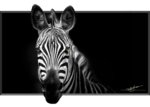

On the west wall of Old Town’s Absolute Gallery is a photo of three cheetahs licking each other’s faces. Fowler-based photographer Eric Johnson calls it “Triple Joy.” It looks like a love fest, but the backstory makes the hair on your neck stand up.
Holding court at Friday’s opening of his lush, vivid wildlife images, Johnson had a lot of backstories to share.
Just before the photo was taken, a mother cheetah took down a young gazelle, but didn’t kill it right away, to give the cubs in the photo some hunting practice.
Even for a man whose day job involves photographing crime scenes, it was tough to watch.
“The mother gazelle was off to the side, bleeding,” Johnson said. “We watched the cheetahs chase it, knock it down, let it back up until they finally killed it and ate just about every last bit of it.”
Johnson’s telephoto lens captured the cubs affectionately (or just hungrily) licking the gazelle grease off each other’s faces. It’s true what they say — the family that preys together stays together.
In old movies, there’s always a blowhard at the party who never stops talking about his African safari.
“The lion was only 50 feet away,” he brags, just before a pie hits him in the face.
Johnson is the opposite. Quiet and methodical by nature, he leaves you wanting more.
Nine of the pictures on the Absolute Gallery wall were chosen from thousands of entries as a National Geographic Picture of the Day.
One of them is a portrait of a huge, angry lion with two cubs jumping over him, taken at Ngorongoro Crater in Tanzania. Johnson was about 50 yards away.
To photograph a group of silverback gorillas in Rwanda, he hiked to an altitude of 10,000 feet.
“It was the hardest thing I’ve ever done, physically,” he said. “I didn’t think I was going to make it.” This time, he didn’t need a telephoto lens.
The curious gorillas peered at Johnson, walked up to him and his wife, Val, and poked at their cameras. One young gorilla grabbed Val’s leg and went for her cellphone.
“You’re supposed to stay 10 meters away, but they don’t know about that rule,” Johnson said.
The most remarkable image is an alpha male gorilla, lounging pensively in the foliage, leaning on his left arm. Johnson jokingly calls it the “Burt Reynolds” shot. (It’s the same pose the actor struck in his nude Cosmopolitan centerfold.)
Johnson, a native of Battle Creek, retired in 1979 after 31 years with the state police. He is now the only certified forensic photographer in Michigan and works with more than 60 law firms and 100 attorneys. Between that and his nature photography, he is seldom without a camera in his hand.
“It’s a great retirement,” he said.
He’s been photographing wildlife most of his adult life, but never sold or exhibited any of his work until recently.
All of his proceeds from print sales are donated to three conservation groups: Save the Rhino, the Sheldrick Wildlife Trust and the Sepilok Orangutan Rehabilitation Center.
“My goal is to show these animals to people who otherwise wouldn’t see them, so they think about these animals and how many of them are endangered,” he said.
The work requires almost superhuman reserves of patience.
It took Johnson 14 hours to get a portrait of a barred owl that will appear on the cover of the next issue of The Jack Pine Warbler, the magazine of the Michigan Audubon Society. He learned of the owl’s nest in Kensington Metro Park near Milford and just staked out the tree until the owl showed up and the light was right.
Even Johnson’s infinite patience doesn’t always pay off. On one photo shoot, he got permission to set up shop near an eagle’s nest and started photographing a baby eagle at two weeks old. When it looked like the eagle was about to fledge, Johnson camped out from sunup to sundown for 13 straight days. On the morning of the 14th, he had an appointment he couldn’t postpone. When he came back, the eagle was gone.
There’s a happy ending, though — he came back after a week and caught the eaglet when it soared on its first thermal current, before it had even learned to fly.
Many of Johnson’s images show animals in quiet, even pensive, moments, but his eye is quick to capture sudden action as well. On one of his African adventures, he watched a cattle egret — a slender midsized white bird — jump from the neck of a huge Cape buffalo to the ground. The buffalo bowed its massive head, allowing the egret to pick a few tasty parasites out of its nose. Johnson caught the fleeting study in contrast between the delicate egret and the hulking buffalo.
The scariest photo on the wall is a fearsome, open-mouthed 10,000-pound hippo surfacing from the Mara River in Kenya, looking like someone just told him some very bad news.
“Hippos are responsible for more human deaths than any other animal in Africa,” Johnson helpfully noted.
After witnessing primal scenes like these, many people would reach for a stiff drink as soon as they reached camp.
Johnson has only one thought.
“I can’t wait to get my photos loaded,” he said.
Eric Johnson: Visions of Wildlife
Absolute Gallery
307 E. César E. Chavez Ave., Lansing
(517) 482-8845
Support City Pulse - Donate Today!
Comments
No comments on this item Please log in to comment by clicking here